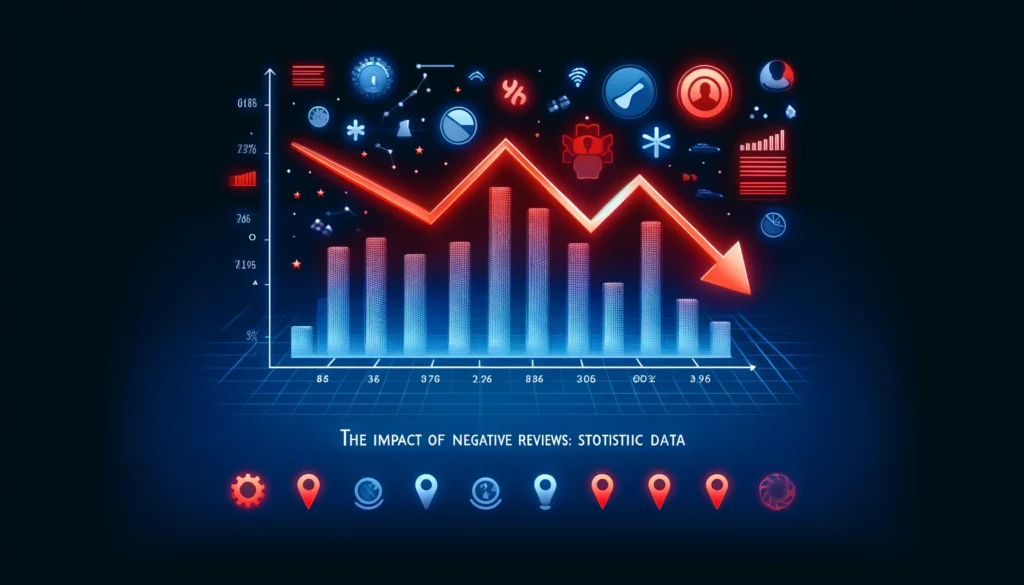Handling negative reviews can be a daunting task, but with a well-thought-out strategy, you can navigate them successfully and safeguard your company’s standing. This guide offers actionable advice and relies on data to demonstrate how to transform negative feedback into a catalyst for improvement and business development.
What are Negative Reviews?
Negative reviews are responses from customers who are unhappy with a product or service. These reviews can be found on different platforms such as Yelp Reviews, Tripadvisor Reviews, Google Maps Reviews, Facebook Reviews, and specialized review sites for specific industries. They vary in severity, from light criticism to serious complaints, and can have a significant impact on the decisions of prospective customers.
The Impact of Negative Reviews: Statistical Data
Negative reviews have become a significant problem for businesses of all scales. A recent survey by BrightLocal (2021) found that 87% of consumers read online reviews for local businesses. Notably, almost half (49%) of these consumers demand a rating of four stars or higher before choosing a business. Studies have also shown that a single negative review can deter roughly 22% of potential customers, while 3 negative reviews can result in a drop of 59% in customers.

How to Respond to Negative Reviews?
Be Prompt and Courteous
Quickly responding to negative reviews is not just good manners—it’s good business. A prompt reply shows you value customer feedback and are attentive to their needs. Remember, a significant portion of consumers, over half according to one study, expect businesses to respond to their concerns within an hour.
When you meet or exceed these expectations, you positively influence how both the reviewer and potential customers perceive your brand. This responsiveness can transform a potentially harmful situation into an opportunity to demonstrate your commitment to customer service.
Address the Issue Directly
When responding to a negative review, it is crucial to address the specific concerns raised by the customer. If the complaint has merit, offer a sincere apology and clearly outline the steps you will take to rectify the problem. This approach not only shows that you are taking the feedback seriously but also helps rebuild brand awareness.
For instance, if a customer complains about a product defect, you could offer a replacement or a refund. Directly addressing the issue can prevent further damage to your reputation by showing other customers that you are proactive about resolving complaints.
Offer to Take the Conversation Offline
Inviting the customer to continue the discussion in a more private setting, such as via email or phone, can often be more effective for complex issues. This move demonstrates your willingness to go the extra mile to ensure the customer’s satisfaction. It also helps de-escalate the situation by moving the conversation away from the public eye, where ongoing negative interactions could attract more attention.
Taking the conversation offline allows for more personalized interaction and often leads to a resolution that is more satisfying for the customer. Plus, it can prevent the airing of potentially sensitive information or prolonged public disputes, which can be beneficial for maintaining a more controlled and positive online presence.

Turning Negative Feedback into Positive Change
Effectively managing negative feedback involves two key strategies: learning from each review and training your staff. These approaches not only help mitigate the effects of negative reviews but also contribute to a positive business transformation.
Learning from Customer Feedback
Identify Patterns and Pain Points
Regularly analyze the negative reviews to identify common issues. For example, frequent complaints about late deliveries suggest a need to reassess your logistics.
Implement Solutions
Based on the feedback, implement changes to address these issues. This might involve choosing more reliable shipping partners or adjusting your delivery policies.
Measure the Impact
After implementing changes, monitor new reviews and customer feedback to assess the impact of your adjustments. This helps you understand if your solutions are effective.
Enhancing Staff Training
Regular Training Sessions
Conduct regular training with your staff focusing on customer service excellence. Use negative reviews as learning tools to illustrate how not to handle customer interactions.
Role-Playing Scenarios
Include role-playing exercises in your training to help staff practice handling difficult situations, such as responding to unhappy customers.
Feedback and Improvement
Encourage staff to provide feedback on training sessions and suggest improvements. This makes training more relevant and effective.
Building a Positive Work Environment
Foster Team Spirit
Create a supportive atmosphere that encourages staff to deliver their best customer service. A happy team often leads to happy customers.
Recognize Good Performance
Regularly recognize and reward staff for positive customer interactions. This not only boosts morale but also incentivizes good service.

Leveraging Positive Reviews to Counteract the Negative Ones
Positive reviews play a crucial role in balancing the scale when your business faces criticism. By proactively encouraging happy customers to share their experiences and showcasing these positive interactions, you can significantly enhance your company’s online reputation.
Encouraging Satisfied Customers to Leave Reviews
Make It Easy to Leave Reviews
Provide clear, simple paths for customers for feedback collection. This could involve sending follow-up emails with direct links to review platforms or having visible prompts on your website and receipts.
Ask at the Right Time
Timing is key when asking for a review. The best moment is often right after a purchase or a positive interaction when the customer’s satisfaction level is high.
Incentivize Reviews
Consider offering a small incentive for customers who leave a review. This could be a discount on their next purchase, a small freebie, or entry into a contest. Make sure to comply with the guidelines of review platforms regarding incentives.
Highlighting Positive Testimonials
Feature Reviews on Your Website
Create a dedicated section on your website for customer testimonials. Update this section regularly to reflect recent positive feedback.
Use Reviews in Marketing Materials
Incorporate positive reviews into your marketing materials, such as brochures, advertisements, and social media posts. This not only showcases real customer satisfaction but also serves as powerful social proof to prospective customers.
Respond to Positive Reviews
Just as responding to negative reviews is important, acknowledging positive reviews shows appreciation and encourages others to share their thoughts. A simple thank you can go a long way.

Monitoring Your Online Reputation
Effectively managing your online reputation involves staying proactive about what is being said about your business across various platforms. This is essential not only for addressing negative feedback promptly but also for leveraging positive reviews to enhance your business’s image.
Review Monitoring Regularly
Set a Routine
Establish a routine to check review sites regularly—daily, if possible, especially for high-traffic businesses. This helps in quickly spotting trends and addressing issues before they escalate.
Cover All Bases
Ensure you’re monitoring all platforms relevant to your industry, such as Google reviews, Facebook Reviews, and industry-specific sites like TripAdvisor or Yelp, depending on your business type.
Use Tools to Help
Review Automation with Checkthereviews
Utilize online reputation management software like Checkthereviews to streamline the process. Checkthereviews can automatically track reviews and mentions of your business across the internet, alerting you to new posts and feedback in real time.
Features of Checkthereviews
Checkthereviews offers features like sentiment analysis, which helps gauge the overall sentiment of the feedback. It also allows for managing and responding to reviews directly from the platform, making it easier to engage with customers efficiently. Additionally, Checkthereviews enhances user experience with Insightful reporting, providing detailed analyses that help businesses understand trends and customer needs. Mobile access ensures that managers can monitor and respond to feedback on-the-go, while Performance metrics offer a quantitative look at how different aspects of the service are performing. Finally, Real-time alerts keep the team up-to-date with immediate notifications about new reviews and customer interactions, enabling quick and effective responses.
Integrate Across Platforms
Integration capabilities of tools like Checkthereviews mean you can bring together feedback from multiple sources into one unified platform, offering a comprehensive view of your online reputation at a glance.
Conclusion
Dealing with negative reviews is crucial for a good business image. Respond quickly and politely to show you care about your customers. Use negative feedback to improve areas like service or product quality. Ask happy customers to share their good experiences to offset the bad ones.
Tools like Checkthereviews can help you keep an eye on your online reputation, so you can stay on top of reviews and keep a good image. Always try to get better and stay positive because every problem is a chance for your business to grow.







